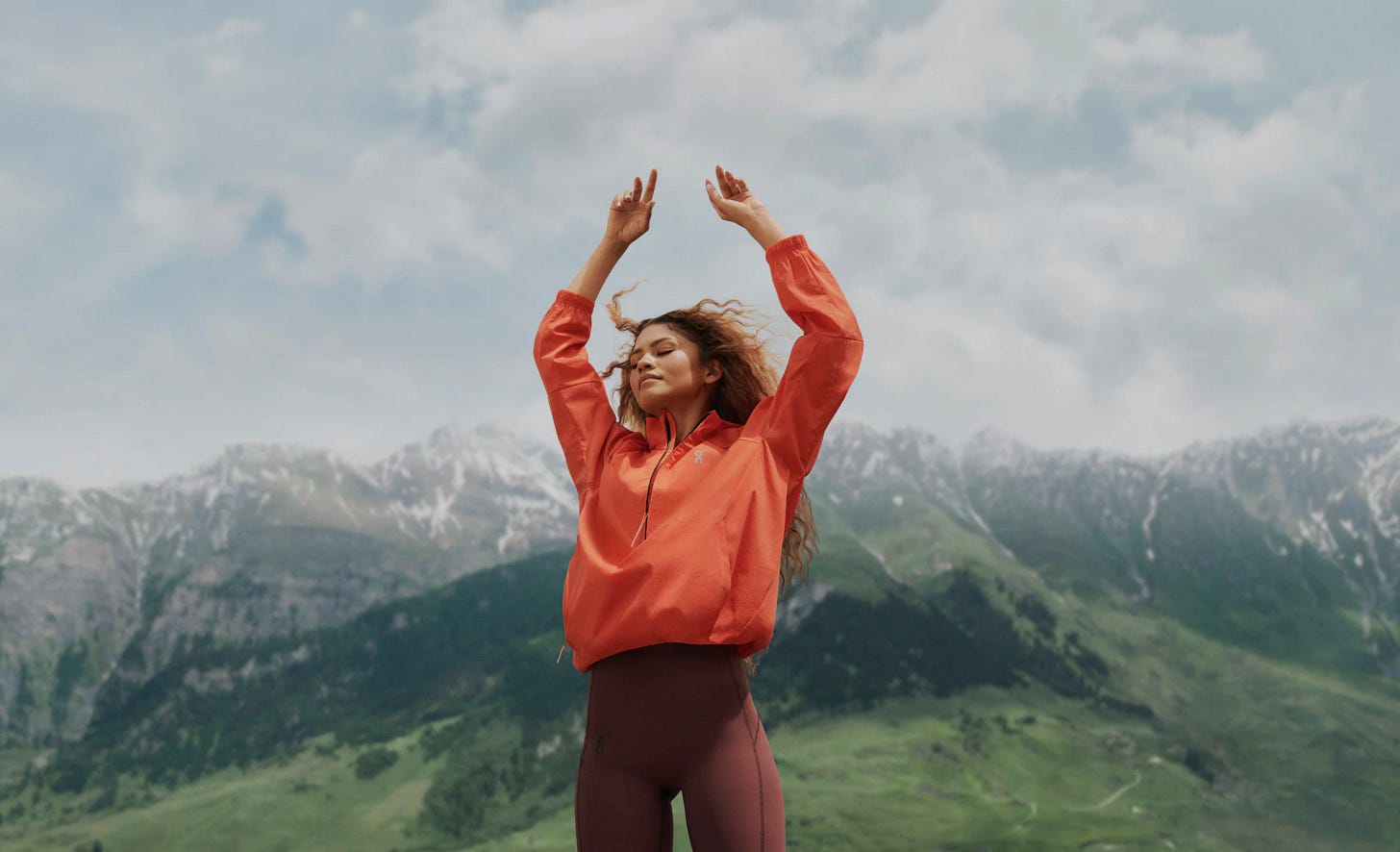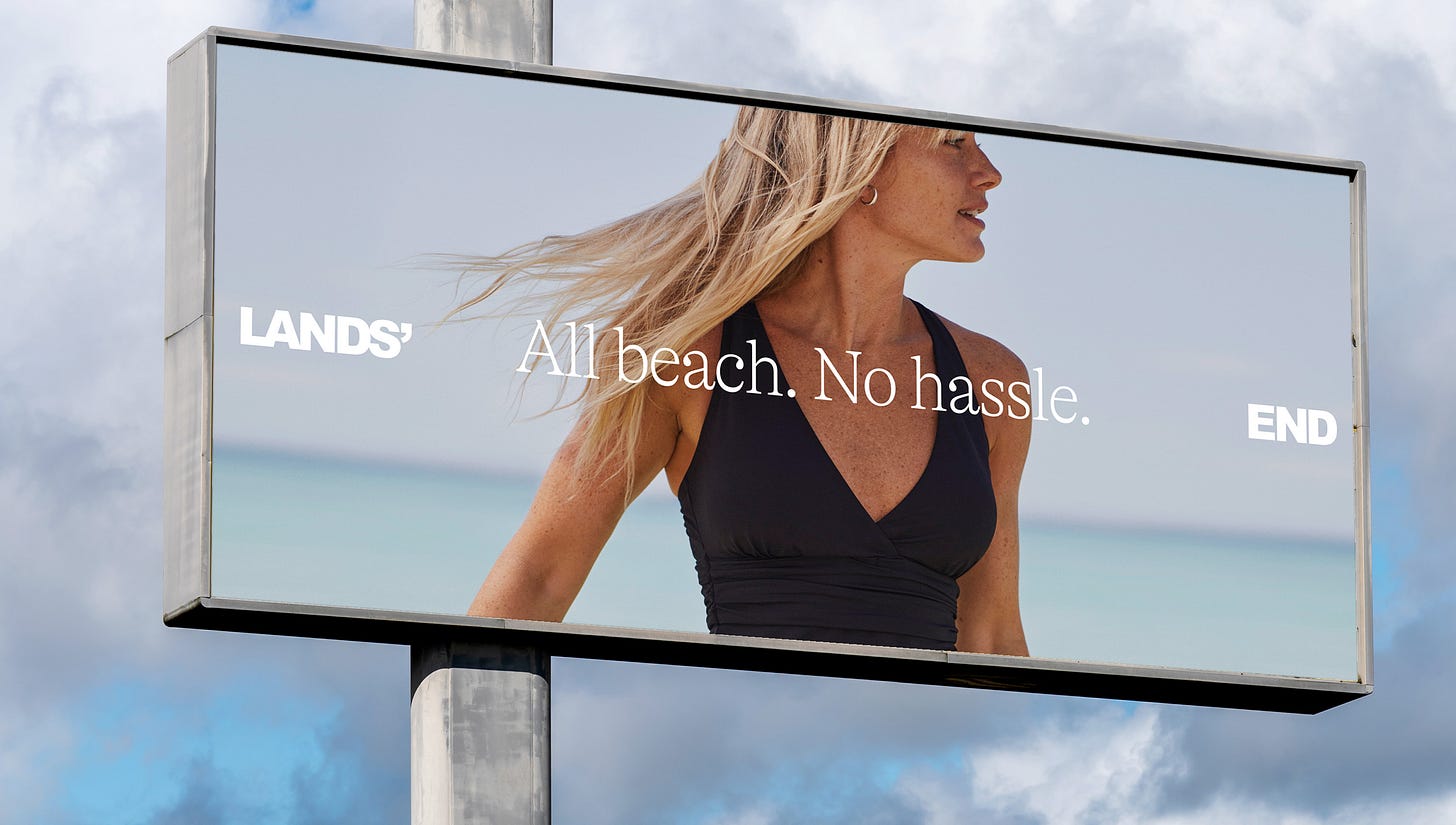Ahhhh, exhale!! This post is about The Great Outdoors. The majesty of experiencing solitude on wind-swept pastures, the bliss of a hike past creosote bushes and catci, the beauty of a glassy ocean swim, that icy thrill of a mountain descent.
No, this is not about that, although I’d love for this post to be impressionistic. Rather, this is about the idea of the outdoors and how brands capture it. First, a little audit of what I’ve recognized at the intersection of habit, culture, and brand. Sweeping generalizations incoming.
At least in 2024, and likely into 2025, running clubs defined the idea of “out” in American cities. From Venice Beach to Manhattan, outside (the branded version of it) meant running in large groups. In New York, in a close second, was walking—whether to meet a step count or to experience yourself as the main character, feel your own vanity. This has been branded as the “hot girl walk.” The style for both run clubs and the hot girl walk is matchy-matchy, sleek, and intentionally accessorized.
I believe the male equivalent to a “hot girl walk” is strutting around the city in gorp-core. Gore-tex makes men smug. You are damp, but them? Dry as hell. They love to conquer nature.
To offer up a place outside of cities, let’s look at Encinitas, a place where people are… actually outside: surfing, fishing, whatever. Vuori, founded in this perfect beach town, connects “being outside” to New Age Mindfulness (On does this too.) The natural world often appears in their brand marketing copy (“the rise, the shine,”) and they prioritize southern cal action sports.
But how do brands tackle the city-dwellers, those who primary idea of outside remains in the realm of the jog and the aesthetic walk? How do they participate in the run-club-hot-girl-gorp zeitgeist? The brands that are doing it best have a story, and they are going beyond sponsoring a run club (but they’re doing that too.)
People in the city desperately want to be out of the city. It’s why so many of my friends have trad-wife content fed to their algorithm (it’s not about the lobotomized way of living, it’s about the chickens, the pastoral idea, imagining both toes on grass and the wideness of that sky.)
Astute brands know that in our cramped apartments, on the packed subway, in the stuff of being stuck, we’re all thinking of the great outdoors, feeling the call of the wild.
There are three brands that I believe are targeting urbanites exceptionally well. No surprise here, each ones has a focused brand story that comes through in every campaign. As Ana Andjelic said in The Sociology of Business, “Editorial - no matter how polished, and no matter who is in front of or behind the camera - lacking the bigger story is just a short-lived attention play.”
Let’s look at recent campaigns from On, Lands’ End, and Arc’Teryx and how they relate to their core brand positioning.
Like Vuori, On connects being outside with the profound.
Here’s On’s Brand Position, condensed for clarity and relevance.
On was born in the Swiss Alps in 2010 with the mission to ignite the human spirit through movement. On’s has attracted a fast-growing global fan base – inspiring humans to explore, discover and Dream On.
And look what we have in this beautiful campaign with Zendaya.
We see movement, an obvious display of immeasurable spirit (they chose the right star for partnership), and a transportive ethereal quality, with the tagline “Dream on.” Certainly, lolly-gagging through the Swiss Alps is an excellent way to imagine and “ignite [our] spirit.”
Meanwhile Arc’teryx (beloved by men on their gorp-core walks) positions itself around performance. This idea of "outside” (and its ability to save us) is not connected to a relaxed twirling of wildflowers, but rather, to accomplishing some magnificent feat of athleticism.
Here’s Arc’Teryx’s Brand Position, condensed for clarity and relevance.
Arc’teryx is a Canadian company based in the Coast Mountains. Our design process is connected to the real world, focused on delivering unrivaled durability and performance in extreme conditions.
We see this position come to life in the 34-year-old brand’s first global campaign. Called “No Wasted Days,” the film series followed a number of incredible outdoor adventurers.
Here’s the copy from under one of the campaign videos:
“We all have a choice. Do we take what we’re given or create something better? Lay low in the valleys or chase ridgelines? Uphill effort is the antidote to the modern grind.”
It’s all about performing & preserving under extreme conditions. No wonder this brand has such a resonance with the guys of New York (always grinding.) Arc’teryx, much like On, promises salvation through its idea of outside. However, the brand says we reach that point through challenge and effort. Joy here doesn’t come through dream but through pointed victory. I don’t expect to see an A-lister prancing about softly in one of their campaigns anytime soon.
Not all successful brands claim suggest that outside will save us. Lands’ End recent brand transformation and new position owns the sweetness of the everyday. Here, “outside” does not induce dream, does not challenge us. This brand story is all about our unremarkable outdoor experiences and what they really look like.
Here’s Lands’ End Brand Position, condensed for clarity and relevance.
Lands’ End is a classic American lifestyle brand that creates solutions for life’s every journey.
Unlike On’s message of “igniting the human spirit” and Arc’Teryx messaging that “Uphill effort is the antidote to the modern grind,” here the story revolves around the simple idea of embracing it out there. It’s casual, friendly, inviting. It’s not asking us to move & dream or to challenge & accomplish. Here we don’t see the aspiration of the Swiss Alps or the drama of a snowy Vancouver peak.
“Love where you go. Love what you wear,” one campaign slogan reads.
Okay, I am going to put on my ugly puffer, head outside (to the real outside, not the idea of it), and sprint to my bodega. Bye.
PS will run clubs continue? will the walks? what major trend are we going to see in cities in 2025?











